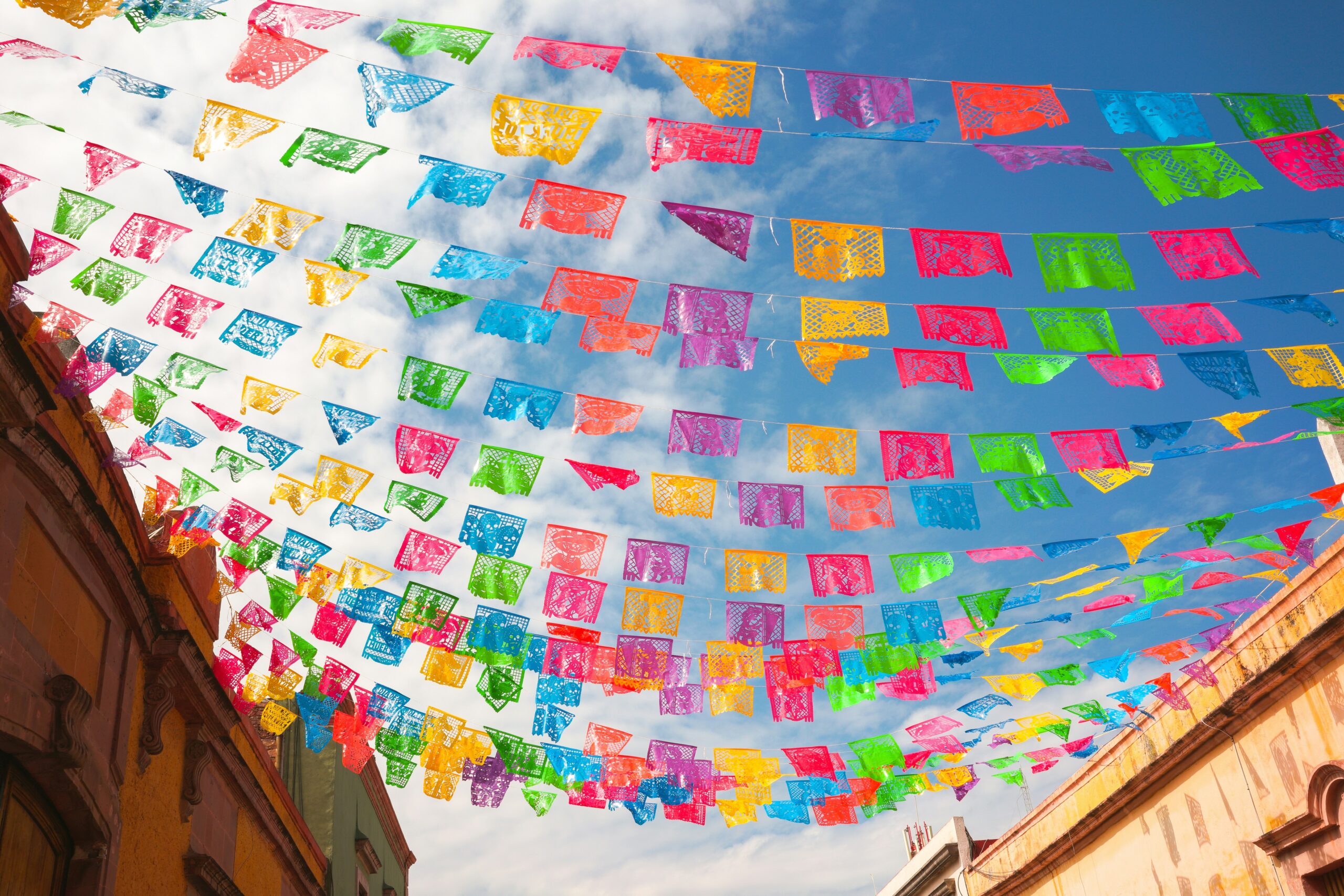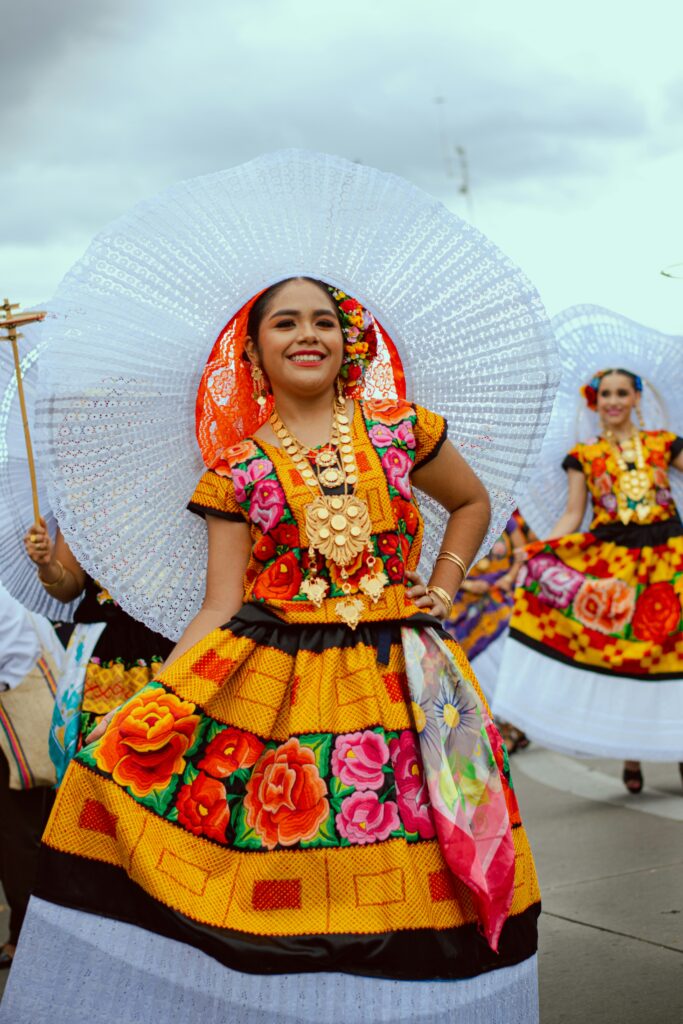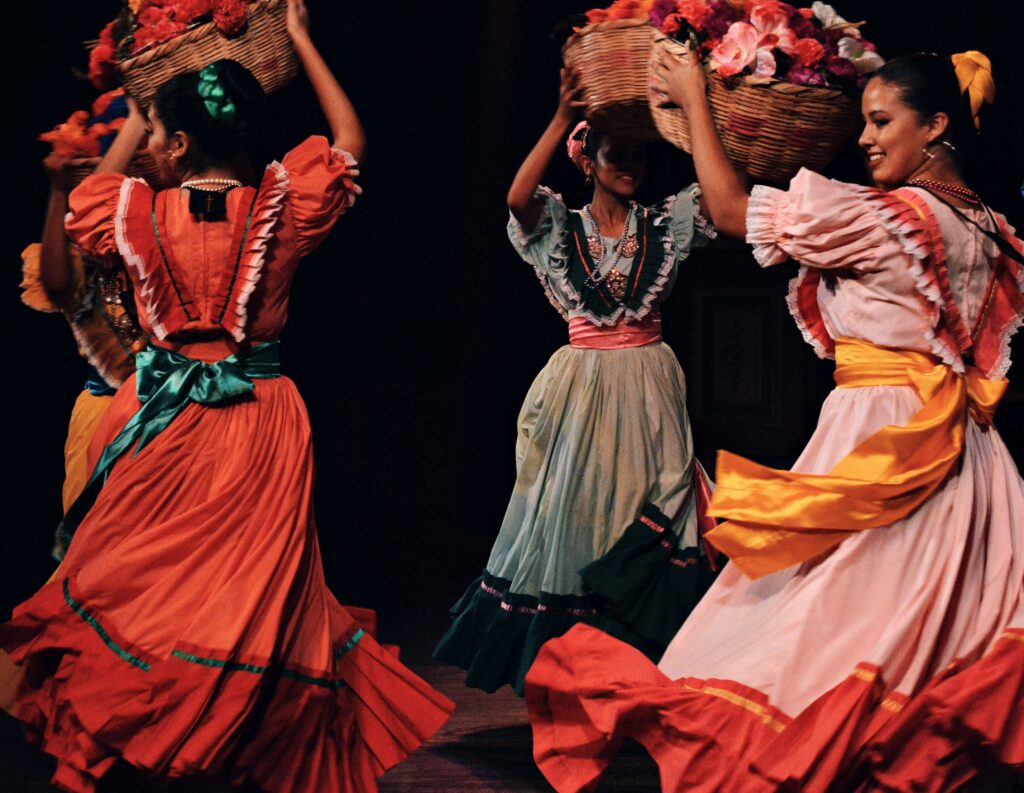
To celebrate Hispanic Heritage Month from September 15 to October 15, many families reflect on and honor the unique blend of their cultural identities. Hispanic Heritage Month is dedicated to commemorating and reclaiming stories and traditions that have shaped our lives.
For those living between cultures, such as those who are both Black and Mexican, Hispanic Heritage Month is not just about tradition, but about ongoing discovery. Through shared experiences in classrooms, community centers, college dorm rooms, and the hospitality of those who become like family, many find meaningful ways to connect with both sides of their heritage and piece together a mosaic of identity.
Discovering My Own Hispanic Roots
Spanish was not spoken in my family when I was growing up. I didn’t grow up dancing to rancheras in the living room or inheriting Abuelita’s recipes. My heritage was revealed to me in a quiet, steady, and unheard voice. I discovered it in Gloria Anzaldúa‘s poetry, East L.A. murals, experiences in New Orleans and friends’ laughter, which taught me how to roll my r’s and cook tamales (I’m still working on it), as well as how to speak Spanish. I studied Spanish for six years in college, and then lost it, but I do understand it by instinct sometimes.
I discovered my own Hispanic heritage in my own way, through understanding and learning.
To celebrate Hispanic Heritage Month as a bicultural familia means commemorating both roots and wings, to cook arroz con pate, to exchange stories of perseverance, and to mix Celia Cruz with Kendrick Lamar on the same playlist. To me, Hispanic Heritage Month means educating our children that identity isn’t a box, but a garden with each tradition planted, each memory watered.

Heartwarming Hispanic Heritage Month activities include food and stories to music, dance, and artwork. Such meaningful activities allow families to connect with their heritage and pass it on with pride.
The Rhythm of Heritage: Discovering Bicultural Identity
Growing up in a bilingual household means that two worlds collide, sometimes peacefully and other times in quiet hostility. For all of us, this means finding a careful balance between legacy and advancement, tradition and change. Learning to keep the rhythm of your heritage while balancing with the beat of the current.
I searched college halls, community fiestas, and conversations with elders who, upon discovering who I was, stood taller in recognition to find out more about my other past.
I came to understand that you do not inherit your identity; rather, you construct it, brick by brick, memory by memory.
What it Means to Grow Up Bicultural
Bicultural identity isn’t something you claim; it’s something you experience. It means that two cultures, often with two languages, values, and expectations, shape you. You might celebrate both Juneteenth and Día de los Muertos. You might eat birria tacos on Sunday and soul food on Monday. You might fit in both cultures, or feel like a guest in both.
“As many with two beautiful heritages, it’s a mixed bag. Great experiences, but also the feeling that you don’t really fit into one or the other… because you belong to both.” —My Aunt, Sheila Gonzales-Lambert
Experiencing and treasuring both cultures you come from can be enriching, offer a broader vision, and deepen empathy. Resting Tree Counselling contends that “studying bicultural identity is required to develop cultural competence, emotional resilience, and a sense of belonging.”

It’s not just about straddling two cultures; it’s about integrating them into an emergent sense of self.
Balancing Dual Heritage: Challenges and Blessings
Negotiating double heritage is a blessing and a curse in itself. There’s the hurt of not knowing enough, being a stranger in a place where you ought to be home. But there’s the joy of discovery, as when you try the birria for the first time and you feel something old stirs within you.
Or, stumbling upon a quote that feels like it was written just for you:
“We have to be more Mexican than the Mexicans and more American than the Americans, both at the same time! It’s exhausting.” —Abraham Quintanilla, Selena (1997)
Living between cultures can feel like walking a tightrope. There’s the challenge of identity confusion, wondering if you’re “Latinx enough” or “Black enough.” There’s the pressure to code-switch, to translate your experiences for others who don’t share them. And there’s the ache of being misunderstood, even within your own family.
I’ve been on that tightrope, either due to being a “no-sabo kid,” and not enough on either side.
“I remember during my law school interview, one panelist asked how I got a last name like Gonzales. Another wondered why I spelled it like the Portuguese.” —My Aunt, Sheila Gonzales-Lambert
But there are blessings too. Bicultural individuals and children are more likely to develop strong communication skills, creativity, and adaptability. Raising bicultural children, according to The Parentz, results in increased self-esteem and enhanced problem-solving skills in those who can successfully integrate their two cultures. These are valuable skills not only for identity exploration, but life.
That’s why Hispanic Heritage Month activities that encourage cultural exploration can be so effective on young minds.
The Importance of Intentional Cultural Preservation
Self-aware preservation of culture is an act of love. It’s choosing to learn, to inquire, to show up. It’s passing on the stories even if they weren’t passed along to you. It’s announcing: I may not have gotten all of the traditions, but I will make sure my children get them.

That’s the beauty of Hispanic Heritage Month activities, to leave space for memory, meaning, and connection. Whether through music, food, or storytelling, these common experiences become bridges between the old and the young.
Hispanic Heritage Month Quotes
If you’re looking for inspiration to share with your family or community, Hispanic Heritage Month quotes are a wonderful means of stimulating pride and debate. Cultural story guides are one of the resources that may be used to document and pass on traditions.
“Preservation of one’s own culture does not require contempt or disrespect for other cultures.” – Cesar Chavez
Online platforms and multicultural community-focused services dedicated to cultural heritage can serve as valuable guides in this journey. There is immeasurable impact in coming together to reflect on family identity. The words of César Chávez, the poetry of Julia Alvarez, and the wisdom of Dolores Huerta remind us that our existence matters, and that preserving it in one piece is an act of revolutionary love.
“My mother gave me one piece of advice that stuck with me. She said don’t forget where you came from.” – Dolores Huerta
Celebrating Hispanic Heritage Month Through Food

Through the study of history, stories, and other means, I got swept up in cuisine that all made me feel more at home inside myself.
I found my heritage in quesadillas cooked on the comal. In birria tacos with spice and heart. In Mango Preparado, all together sweet and tart, messy and joyful. Mixing soul food and Mexican fusions makes me feel at home in myself. I explore my Hispanic heritage in flan, my signature dessert, smooth and golden as a lullaby. These are not just meals, they are whispers. These recipes are how my ancestors whisper to me in every bite: “We’re still here.”
Hispanic Dishes That Bring Generations Together
During Hispanic Heritage Month, food is front and center. Families gather to prepare those meals that have been passed down through the years. Tamales painstakingly wrapped, or pozole simmering over the course of hours, these foods carry the weight of memory.
For those looking to dive into traditional recipes, check out Muy Bueno Cookbook, which boasts a rich catalog of Latinx recipes that honor regional taste and family tradition. Cooking together is, therefore, one of the most meaningful Hispanic Heritage Month activities, especially when elders can pass along stories alongside the spices.

Fusion Meals That Reflect Bicultural Creativity
In bicultural homes, the kitchen is a lab of love. We blend, we fuse, we innovate. For example, a cheese quesadilla can be made with jerk chicken. A mango can be sprinkled with Tajin and Louisiana hot sauce. These foods are a reflection of who we are, unapologetically complicated.
If you are asking yourself how food can be a form of identity, explore the Smithsonian’s Latino Center for the connection between cuisine and culture, and how food evolves across borders and generations.
Cooking With Kids: Recipes as Storytelling
Inviting children into the kitchen is about more than just having a good time, it’s about passing on heritage. Ask them to squeeze the lime, mix the masa, and ask questions. Tell them where the recipe comes from. Tell them who first created it. Remind them that every meal has a name, a place, a heartbeat.
These ritual tellings are some of the best Hispanic Heritage Month activities for families who wish to come together through food. For families who may not cook traditional dishes, sharing food stories or drawing favorite meals can be equally impactful.
Creating a family food storybook with hand-drawn illustrations or writing about memorable meals allows everyone to engage with their heritage in a meaningful way. And if inspiration is what you’re looking to pass along to your children, give a try at using Hispanic Heritage Month quotes that celebrate food and family.
“The table is a place of connection, not just consumption.” – Chef José Andrés
Passing Down Stories & Language: Honoring Heritage
Stories are more than just amusement in bicultural households; they are vital. They carry the burden of migration, survival, and contentment. When the outside world fails to remind us of who we are, our stories do. I never heard bedtime stories in Spanish growing up. However, I now see that multilingual storytelling is a preservation gift.
Preserving Hispanic Oral History and Traditions
Oral histories, whether hushed over coffee or screamed out during games of dominoes, are sacred. They are how abuelitas recount family histories, how tíos recount border crossings and barrio pride. These traditions are incorporated into our celebration of Hispanic Heritage Month activities, especially when passed down from one generation to the next.
Tradition is an ever-evolving and dynamic concept. It changes. It shifts.
As you plan out your Hispanic Heritage Month activities, you can create new traditions that honor both sides of your ancestry. Perhaps it’s a storytelling circle, where each generation shares a memory. Maybe it’s a recipe night, with elders teaching how to make dishes like tres leches or flan. Or maybe it’s a mixtape that spans generations and borders, blending rhythms, languages, and legacies into one shared sound.

The Value of Hispanic Oral History and Traditions
The keys to cultural wisdom are in the hands of seniors. When we listen to what they have to say and let them know that their stories are important, all family members can benefit.
“Oral traditions, such as storytelling, endure and evolve over time as the cultures they belong to evolve, and oral traditions continue to both record and affect people’s communal and individual identities and lives.” – The Oral Traditions of Hispanics, Latino Literacy
Valuable Hispanic oral traditions including storytelling, lyric poetry, folk prayers, and proverbs, all of which serve as a vehicle for transmitting values, history, and identity. Younger generations gain a better understanding of their place in the family and society at large through these oral histories.
Celebrate Hispanic Heritage Month Through Oral History
Think about collecting family tales, conducting interviews, or making a multilingual scrapbook if you’re searching for celebration ideas. Let Hispanic Heritage Month quotes guide the experiences of your family. One that strikes a deep chord for me:
“It is important for all of us to appreciate where we come from and how that history has really shaped us in ways that we might not understand.” – Sonia Sotomayor

Rooted in Rhythm: Music, Memory, and Identity
If food is a memory, then music is movement. It’s the rhythm of Latinx life, bouncing around family gatherings, backyard barbecues, and living room dance floors. From salsa to cumbia, bachata to reggaeton, these rhythms carry joy, resistance, and identity. For bicultural homes, playlists tend to blend styles like Selena, Erykah Badu, Bad Bunny, with Kendrick Lamar, reflecting the multi-layered richness of who we are.
Music, dance, and art are more than expression, these are vessels for identity. For bicultural families, music and dance is a chance to honor both sides of heritage. An anecdote from when my aunt told me about my cousin, Sage Gonzales-Lambert’s heritage:
“Your Uncle Doug is Belizean American. When I went down to Belize to visit with his mother and family, just getting an idea of the culture, foods, clothes, etc. sparked in me an interest in knowing more about my own Latin heritage. We attended a Ballet Folklorico when Sage was little. You can learn so much about a country, its culture, and its people. The regional dances provide the cultural, musical, and historical context for why and how things exist. Our dance familia literally embraced us and taught us a lot, from tamales to dishes that I still make today, religious traditions, and rituals. Sage is the first from our family to have a Quinceañera. I am proud that I was able to document her experiences from both of her worlds. She has the best of two worlds, and I hope that she will continue to pass on the traditions that she enjoyed as a child.”

In Afro-Mexican enclaves in Guerrero and Costa Chica, and Oaxaca, music and dance become ritual acts of remembrance. The Danza de los Diablos, danced on Día de Muertos, mixes African and Indigenous ritual – horns, rattles, and drums producing family-like rhythms. But to celebrate our origins is a question of amplifying the rhythms of Afro-Latinx heritage, specifically those previously marginalized.
Legacy of Freedom: The Story of Gaspar Yanga and Afro-Mexican Roots
Our Afro-Latinx heritage runs deep. In the 16th century, enslaved Africans came to Mexico, and they fought back. Arguably, the most compelling story is that of Gaspar Yanga, who led a successful uprising and founded San Lorenzo de los Negros, now Yanga, Veracruz, the oldest known free Black municipality in North America. The legacy remains today in the music, dance, and oral traditions of Afro-Mexicans in Veracruz, Guerrero, and Oaxaca.
But despite centuries of cultural contributions to Mexico, Afro-Mexican identity has been deliberately erased from the national narrative of Mexico. As the Smithsonian Learning Lab observes, this erasure was a strategic political move to adapt to European standards and suppress Blackness. Afro-Mexicans were not counted in census data until 2015 and still face structural obstacles in education, infrastructure, and representation.
In commemoration of Hispanic Heritage Month activities, families can honor this legacy by:
- Creating playlists of Afro-Mexican styles like Son Jarocho and Danzón
- Creating a family flag that incorporates symbols from both cultures
- Viewing films or documentaries that are centered around Afro-Latinx stories
- Dancing together and learning the history behind the steps
Celebrate with Purpose: Constructing Bicultural Pride Tradition by Tradition
Celebrating Hispanic Heritage Month doesn’t always involve intricate planning; the first step is to make intentional decisions every day. These small actions, such as asking your grandparents what their favorite childhood dish was, reading bilingual books to the children, or playing Latinx music while preparing supper, can become significant Hispanic Heritage Month customs if they are done with intention. These could include school art workshops, parades, dance performances, cultural festivals, or storytelling events sponsored by the neighborhood. At-home rituals, such as cooking a traditional meal, lighting a candle in remembrance of an ancestor, or reading aloud a quote that speaks to you, may have just as much impact.

Intergenerational activities are extremely meaningful. Grandparents will give oral histories, parents will include traditions from both sides of the family, and youngsters will bring fresh perspectives to the event. Creating new rituals, such as a family recipe night, a shared soundtrack, or a storytelling circle, can help generations connect and celebrate their bicultural identities. Don’t forget the art.
DIY crafts, like papel picado, piñatas, or Frida-inspired collages can be joyful Hispanic Heritage Month activities for kids and adults alike. Take time to download or search a free activity guide that offers printable resources and cultural lessons perfect for all ages.
Carve out space this month to love who you are, complete and unapologetic. Your identity is multifaceted, unfolding, and worthy of celebration. You’re preserving your heritage no matter if you pass along a recipe, share a family story, dance to a common beat, or start a new tradition. Make this the moment you say: I am proud of where I started, and intentional about where I’m going.
Celebrate both sides of yourself because that’s what it means to really be you.

